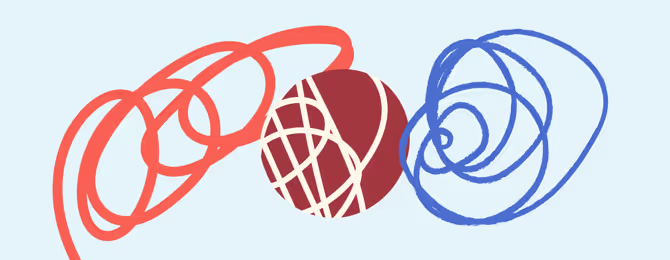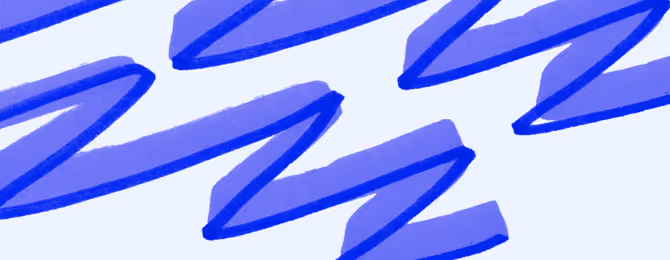Set team goals right: Step-by-step guide with examples

%20(1).png)
Part of a manager's role is connecting their team’s efforts to the broader mission of the company and guiding them along the way. This is especially true in the era of remote work, where ensuring alignment for each team member is as important as ever.
What makes attaining success possible? Team goals that are purposeful, attainable, and aligned with the bigger picture. This comes as no surprise, as 70% of employees report a sense of purpose through their work and, as McKinsey quotes:
“The goal-setting conversation can be a powerful unlock to bring purpose into work and connect the individual to something larger than themselves.”
As leaders, the crucial task of team goal setting falls on your shoulders — it’s your responsibility to establish what needs to get done, what tasks to delegate to whom, and how to bring everyone together to meet every objective.
This article covers everything managers need to set the right team goals. It not only covers why team goals are crucial for business success but also useful steps for setting effective goals with context examples to help guide you in your own goal-setting strategies.
The importance of team goal-setting for business success
When employees have a clear understanding of company objectives and how their work collectively contributes to reaching these, they become an aligned, motivated, and higher-performing workforce — exactly what drives business success.
Think of your team as your own version of The Avengers. Each with a unique skill set, able to come together thanks to a shared mission. This, obviously, doesn’t just happen out of thin air. It takes a dedicated effort at the leadership level to define this mission, with clear goals and tasks delegated to the right individual.
By setting clear, meaningful, and SMART team goals, managers ensure their employees understand the value of their work and how their efforts connect with their organization's bigger picture. Effective team goals support other aspects of performance management too — like team alignment, task prioritization, development and coaching, strengthening collaboration, as well as maintaining healthy team dynamics.
The benefits of setting team goals
Setting team goals creates a roadmap for success that everyone can follow. They set the stage for collective achievement, which in turn helps set individual goals.
When done right, team goal-setting brings a load of value to managerial objectives — but also has a tangible impact on the team's performance and the employee experience. Benefits of team goal setting, for both managers and employees, include:
Team goals establish accountability
When everyone knows what's expected of them, it's easier to hold each other accountable. Clear team goals ensure that every team member stays on track with their responsibilities to collectively contribute their best — preventing one employee from unintentionally veering off track and impacting the rest of the team negatively.
Manager tip: To keep everyone on the team accountable, set a goal for each team member to complete weekly status reports on their tasks and progress, which will be reviewed in the team meeting every Monday. This should motivate each employee to hold their end of the stick, so as not to let their colleagues down.
Team goals improve team cohesion
It’s easier to come together through a shared purpose. Team goals are shared goals, and they create a sense of unity within a team. When each team member works towards common objectives, it strengthens collaboration and builds stronger relationships, too.
Manager tip: Organize a monthly team workshop where team members collaborate on a common project or problem-solving activity, aimed at enhancing teamwork and communication. You can use a hypothetical example for this exercise — but by using a real-life challenge the team is currently facing, you kill two birds with one stone!
Team goals increase motivation
Clear and meaningful goals provide direction and purpose. Employees need clarity on the steps they need to take to meet expectations in order to work with confidence. Also, when team members understand the impact of their work, they are more motivated to give their best effort collectively.
Manager tip: Break down team goals vs individual goals and responsibilities — and paint the bridge that connects the two. During team meetings, acknowledge everyone’s individual contributions, and how they collectively impact the team goal progression.
Team goals enhance project outcomes
Setting specific goals for projects not only helps focus team efforts and resources but also provides context to said team efforts. Projects that benefit from clear team goals see better results, as they tend to be completed more efficiently and meet their intended outcomes.
Manager tip: Tune in to what’s worked. Effective project-specific team goals can provide lessons and a great team goal-setting template for future projects. Your team might agree that a certain team goal really helped complete a past project and is worth applying again to the next one.
Types of team goals
Understanding the different types of team goals can help managers set the right ones for their team. Each type serves a unique purpose and can drive different aspects of team performance and collaboration.
Of course, the variety of actual team goals possible is endless — each can be their own, depending on the industry, objectives, project, and team!
Performance goals
Performance goals can focus on improving both individual and team performance. This could mean goals that look to increase sales figures, enhance customer satisfaction scores, or boost productivity.
A performance team goal looks like this: Increase the team's quarterly sales revenue by 15%, with each team member contributing to specific sales targets.
Collaborative goals
Collaborative goals, or collaboration goals, aim to improve teamwork. Examples of team collaboration goals include improving continuous communication within the team or increasing the frequency of team-building activities.
A project-specific team goal looks like: Finalize the design of the new software application by the end of the month, ensuring all initial testing and feedback rounds are completed.
Project-specific goals
Project-specific goals can have a performance or collaborative focus but are tied to projects and initiatives. These usually involve meeting project deadlines, achieving key milestones, or a team delivering specific results — anything that contributes to the project's success.
A project-specific team goal looks like: Finalize the design of the new software application by the end of the month, ensuring all initial testing and feedback rounds are completed.
6 team goal-setting objectives (with examples)
Now that we’ve established the types of team goals there are, let’s talk about team goal objectives. Managers don’t just set goals for the sake of setting goals, after all! Knowing how to set team goals is also about making sure their objectives are aligned with organizational objectives.
Below are some common team goal objectives, with helpful examples to guide you:
#1. Achieving project milestones
Managers can set goals to reach specific project milestones — like completing a research phase, developing a prototype, launching a digital product, or finalizing a project report.
Team goals with project achievement objectives:
- Complete the initial research phase of the new marketing campaign by the end of Q2, ensuring all relevant data is collected and analyzed.
- Finalize the beta version of the software update and have it ready for internal testing by the first week of the next quarter.
- Launch the new customer feedback system within three months, including training for all relevant staff members.
#2. Improving team communication
Crucial to internal process success, managers can also set goals to enhance the frequency and quality of communication within the team. These can look like holding weekly check-ins, implementing a new communication tool, or improving feedback mechanisms.
Team goals with communication improvement objectives:
- Implement a new team collaboration platform (like Slack) within the next month to streamline communication.
- Schedule bi-weekly team meetings to review progress and address any communication barriers, starting next week.
- Create a shared document repository by the end of this month to ensure all team members can access and contribute to project documents easily.
#3. Enhancing team productivity
Managers can also establish team goals that aim to increase overall productivity — like reducing time spent on specific tasks, streamlining workflows, or incorporating new productivity tools into the day-to-day.
Team goals with productivity enhancement objectives:
- Reduce the average time taken to complete standard tasks by 15% over the next quarter by optimizing workflows and using automation tools.
- Implement a new project management software by the end of the next month to better track progress and manage workloads.
- Establish a daily stand-up meeting protocol within the next two weeks to ensure everyone is aligned and aware of their daily priorities.
#4. Boosting innovation
By encouraging team members to propose new ideas and solutions through innovation goals, managers nurture a culture of creativity, initiative, and problem-solving within their teams.
Team goals with innovation objectives:
- Conduct quarterly innovation brainstorming sessions, during which team members propose new ideas for better processes. Implement at least one new idea each quarter.
- Develop a dedicated innovation lab where team members can experiment with new technologies and approaches, aiming to generate at least three viable pilot projects within the next six months.
- Establish an innovation mentorship program that pairs junior team members with senior staff to work on innovative projects, launching at least two new initiatives by the end of the year.
#5. Improving performance quality
Managers can set team targets to reduce the number of mistakes — be it about performance or output outcomes like product defects — by attaching specific metrics like a certain percentage range within a clear timeframe.
Team goals with quality improvement objectives:
- Achieve a 95% customer satisfaction rate for all support tickets resolved within the next quarter.
- Reduce product defects by half over the next six months by introducing a new testing process.
- Increase the accuracy of data entry by 15% within the next quarter through additional training for team members.
#6. Expanding team skill sets
Lastly, managers can encourage continuous learning by setting team goals for everyone to complete certain training courses or certifications relevant to their roles. These not only support individual development but also strengthen collective skills.
Team goals with skills expansion objectives:
- Enroll team members in one professional development course related to their role within the next quarter, ensuring completion by the end of the next quarter.
- Hold monthly skills workshops where team members can share knowledge on specific tools or techniques, fostering a culture of continuous learning and skill enhancement.
- Achieve certification in a new industry-relevant technology for at least 50% of the team within the next six months, so the team stays current with industry trends and advancements.
8 steps to establishing effective team goals
Whether you’re already a team goal-setting expert, or this is your first time establishing a team goal-setting strategy, we’ve got a handy blueprint that helps managers avoid starting from scratch every time.
Check out our short, sweet, practical guide on simplifying the foundations of solid goal setting so you can raise your game and get better results!
Step 1: Understand your organizational and department OKRs
While this step might seem obvious, it’s essential for managers and employees to have a clear and comprehensive understanding of the organization's goals (also referred to as business objectives) and grasp the company’s bigger picture, so everyone’s on the same page.
We suggest OKRs — key objectives and results — as a framework to get started. OKRs are a collaborative goal-setting method used by (and for) teams and individuals to design purposeful goals that can be tracked and measured. The trick is to use organizational OKRs as the reference point for all future team goals.
Questions to help stay aligned with organizational goals:
- Is the team clear on organizational OKRs? Do we need a refresher?
- Does anyone from the team have a creative interpretation of organization OKRs that could be helpful for the rest of the team?
- Have organizational OKRs been recently reviewed? Are they up to date?
- Do we have quarterly or yearly organizational OKR review sessions planned?
Step 2: Host collaborative goal-setting sessions
Once everyone has a shared understanding of the bigger picture, the next step is for managers to establish the who, what, when, and how of team efforts. To do that in a way that certifies buy-in from employees and generates the best ideas, managers should involve the whole team in setting these goals. Collaborative sessions are one of the most effective team goal-setting activities out there!
Questions to pose during goal-setting sessions:
- What areas of the company strategy do we see ourselves reflected in?
- Where can we have the greatest impact as a team?
- Which KPIs does our work contribute to directly?
- Which KPIs does our work contribute to indirectly?
- What sub-metrics of company KPIs is our team responsible for?
Narrowing down where to direct collective focus helps managers (and team members) create clearer goals and more effectively prioritize team initiatives.
Having a centralized location for team members to refer to collective goals promotes transparency and keeps them front-of-mind for everyone. Officevibe's goals and OKR tool make team goals easier to access and align with business objectives and individual employee goals.
Step 3: Build team goals aligned with organizational objectives
Now that everyone is aligned on the bigger picture, and part of the goal-setting process, the next step is to set the team goals — ensuring they’re in direct alignment with the larger company objectives.
This alignment not only helps in maintaining a clear focus for collective efforts but ensures that every team member understands the value of their contribution to the overall success of the business. By regularly reviewing and adjusting team goals to stay aligned with any changes in organizational priorities, managers ensure team efforts never veer off track.
Questions to ask to keep team goals aligned:
- Does each team goal directly or indirectly contribute to organizational goals?
- Are team goals priorities aligned with organizational priorities?
- Are there regular team goal review sessions scheduled?
Step 4: Apply the SMART criteria for team goals
Apart from comparing against OKRs, it's a great idea to also crosscheck team goals against the SMART goal framework — ensuring all goals are specific, measurable, attainable, relevant, and time-bound.
To get started, managers can come up with the first iteration of goals for their teams, layering and fine-tuning them until every SMART criterion is met. This ensures every single team goal is comprehensive and performance-driven — which will make stakeholders extremely happy!
Questions to ensure you’re following the SMART framework:
- Specific: What end result are you looking to achieve? Is it specifically defined?
- Measurable: Can you measure the success of this goal with data? How will you measure it?
- Attainable: Is this a realistic goal to set? Do you have what it takes (resources, knowledge, skills, support) to achieve success?
- Relevant: Is this goal aligned with your team and the company’s broader objectives? Will it bring relevant value to your organization?
- Time-bound: When do you plan to achieve this goal? Is it the right time to do so?
Step 5: Get feedback, iterate, and maintain alignment
Great team goals are shaped by the input of everyone on the team — and maybe even other company stakeholders, like senior leaders and other managers. Managers should tap into collective knowledge and perspectives to sense-check that they’re truly aligned with team realities. Feedback is also a great way to get everyone feeling inspired and motivated to achieve these goals together — as it gives participants a natural sense of ownership and participation.
How often should team goals be adjusted? As needed! By having regular touchpoints, managers ensure their goals and strategies remain aligned, agile, and relevant. Things shift quickly in business — so you want to be sure to hold down your team with a solid sense of direction.
Questions to ask for feedback on team goals:
- Are the goals realistic and achievable given our current resources and constraints?
- Do these goals align with our team’s strengths and areas of expertise?
- Is there anything that might hinder our progress toward these goals that we need to address now?
- How can we improve our approach to achieving these goals based on past experiences?
- Do the goals inspire and motivate you to perform at your best?
Step 6: Turn team goals into action items
Once team goals have been established and the team is aligned, it’s time for managers to translate these goals into tangible action items. This step is one of the most exciting, as it allows employees to directly connect their individual work with the team's objectives.
Have a brainstorming session with your team to come up with ideas for how you’ll all meet shared goals, deciding which ones you’ll tackle together and who’ll take on specific tasks over others. Remember: Adaptability and flexibility with timelines and workflows are essential to making sure the work gets done without compromising quality — and without overloading anyone.
Team brainstorm agenda template (1.5 hours)
- Check-in with the team, get started with a fun icebreaker, and describe the purpose of the meeting. (5-10 mins)
- Review organizational goals and let team members ask any questions they may have. (5-10 mins)
- Kick off the discussion by talking about how everyone can play into their strengths and have the greatest impact. (10-15 mins)
- Provide a recap of previous goals, wins, and challenges. (5-10 mins)
- Have a team goals brainstorm and recap where everyone contributes their ideas on a whiteboard or virtual tool. (30 mins)
- Wrap it up and provide the next steps. (5-10 mins)
Repeat this process every quarter or each time there are important shifts within your organization or team.
Step 7: Monitoring and evaluating team performance with KPIs
Managers should have weekly or bi-weekly team meetings to look at team goal progress — as well as have individual check-ins where team goals are discussed more granularly. Make sure everyone is well-equipped to measure progress with clear key performance indicators (KPIs) and targets, and the necessary tools to track these metrics easily.
Scheduling dedicated, recurring moments to review what’s in the pipeline, and flag any potential roadblocks or risks, will ensure progress tracking opportunities don’t get forgotten when times get busy. Look to AI for extra help — automated team progress reports are also a simple yet efficient way to keep the team in the loop without having to think too much about it.
Team goal KPIs examples:
- Overall task performance
- Individual task performance
- Workload efficiency and distribution
- Collective engagement score
Step 8: Support your team in meeting goals
Being a supportive leader can make all the difference to a team. As a manager, you can empower each employee with a sense of purpose and ownership over their goals — helping them recognize opportunities, commend their efforts, and reassure them that you're always there to answer questions and provide guidance when needed.
Managers need to have their finger on the pulse when it comes to understanding a team’s reality, challenges, and concerns. Officevibe's anonymous feedback tool helps you keep a pulse on your team and facilitates safe exchanges between managers and employees, so you can spot issues early and direct your support where they need it most.
Questions to ask your team in terms of support (but find more here):
- Are you clear on our team goals and objectives?
- Are you clear on your assigned tasks as part of our team goals?
- Are there ways you feel I could better support you — be it mentorship, discussion time, or new tools?
- Is there anyone from our team you feel you’ve learned a lot from and would like to work more closely with?
Senior manager tip: Developing a coaching leadership style is a great way to align each employee’s personal goals with the company’s goals, and ultimately boost performance and amplify employee development.
In-context: 15 team goal examples for managers
Now with the right step-by-step approach to setting effective goals, it’s time to put the theory into action and design your own team goals!
Remember, goals don’t have to be about performance — to help you navigate your goal-setting strategy, we've put together a selection of best-in-class team goals (that are specific, measurable, achievable, relevant, and time-bound) that you can pool inspiration from:
15 SMART team goals examples that you can use:
- Increase month-over-month client retention from 75% to 80% by the end of the third quarter.
- Produce at least one project in a format we’ve never tried each quarter.
- Create one list of team principles to simplify remote collaboration in the next month.
- Obtain a qualified lead score above 30% from all lead generation initiatives this quarter.
- Increase the team’s Relationship With Peers score by 1 point in Officevibe's employee engagement tool by the end of the month.
- Make a video to highlight team wins and share it with other teams in the next month.
- Increase traffic by 5% each month on the website home page.
- Reduce average request response time from 1 hour to 45 minutes in the next 3 months.
- Increase content velocity from 10 to 12 articles per month in the next quarter.
- Implement one initiative to improve recognition in the team in the next month.
- Plan or participate in regular team-building activities, at least once a month.
- Attend 2 industry conferences in the next quarter to grow the company's network.
- Earn a new certification for all team members by the end of the year.
- Gain 100 new social media followers in the next quarter.
- Reduce overtime by 20% by the end of the year.
Feel free to use these team goal examples as they are or tweak them to tailor them to your squad and work realities. Once in place, progress tracking will help you gain better momentum!
Challenges of team goal setting (and strategies to overcome these challenges)
Setting team goals can be incredibly rewarding — but it comes with its own set of challenges. Here are some of the most common obstacles managers might face (and strategies to overcome them):
- Misalignment with organizational goals: Sometimes, team goals don’t perfectly align with broader company objectives. This happens more than you think — and is easy to correct if you regularly check in with senior leadership and ensure your team’s goals are in sync with the company’s mission and vision.
- Lack of clarity: If goals aren’t clearly defined, team members might be confused about what’s expected of them. Make sure each goal follows the SMART criteria, and don’t hesitate to double-check that everyone has the same understanding.
- Insufficient resources: Your team might struggle to meet goals if they lack the necessary resources, such as time, budget, or tools. Address this by assessing resource needs early and advocating for what your team requires to succeed.
- Resistance to change: New team goals can sometimes be met with resistance, especially if they require changing familiar processes. That’s why team buy-in is so important. Overcome this by involving your team in the goal-setting process to ease them in from the start.
- Tracking progress: Keeping track of progress can be challenging — especially with multiple goals with different KPIs. Implement regular check-ins and use project management tools to automate monitoring and progress reporting.
If any of these feel relatable — don’t worry, you’re not alone! Just remember: by proactively addressing these challenges, and nipping the issues in the bud, you’ll be able to set your team up for success (even if a few detours are needed).
What to do when goals aren’t met: Tips for managers
Not meeting team objectives can be disappointing for everyone — especially when your team has worked hard towards their shared goals.
Managers should leverage these moments of challenge to rally their teams. These times prove to be great opportunities to come together even more and use that collective determination to find solutions for the way forward.
Team retrospectives have the power to reveal what went wrong and set action items for how these learnings can be applied to even better team goals for the next time.
Questions to reflect on with your team:
- What blocked our success as a team?
- Were there external factors at play?
- Is there something we could have foreseen but didn’t?
- What have we learned through this experience?
- How can we apply these learnings going forward?
You want to create a safe space where employees feel comfortable sharing their honest perspectives, so you can effectively move forward as a team. One way to facilitate this is by sending an anonymous survey where everyone can answer these questions without fear of being judged or facing conflict.
The Officevibe Pulse Survey tool lets you build personalized team surveys to gather insightful and actionable feedback, and better understand your employees’ experience.
Setting up your team up for success with the right tools and technologies
To build a motivated and high-performing team, each team member should have a sense of purpose in their role, and feel that their work has meaning — both as individuals and as part of a collective. But this magic only happens when everyone has a clear understanding of what’s expected of them and the value of their efforts.
Setting meaningful team goals that align with organizational objectives connects team members to the bigger picture, driving employee engagement and motivation. When team goals are clearly established and managers have team buy-in — then it’s a recipe for success. The steps and examples outlined in this article should contain all the tips you need to know to keep your team on track and motivated.
If you’re interested in taking team goal-setting to the next level, Officevibe’s goal-planning tool is what you need. Its features enable managers to engage and empower each team member through easy-to-follow goal-setting plans, where everyone can access a clear map of the bigger picture and the steps needed to succeed, as well as team dashboards to track their progress and hit their personal goals together.
Eager to simplify the way you work and boost your employee experience?


%20(1).avif)


.avif)
.avif)








